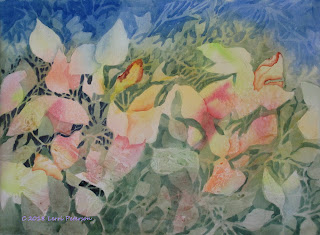(Watercolor Plus project will follow.)
This is the last for this study that I will post because it would just be more of the same and I may not even finish it beyond what I have done, from her out it is up to you to decide just how much or little detail you want to put in, this was more a piece for practice rather than a finished work so a good place to practice detail on the leaves or more negative painting, it is up to you.

Look at leaves and take photos of the leaves as they are changing color, how they change shapes, where bugs have chewed holes, anything that you can see to understand how to paint the leaves.
This is also a place to practice using your brush to make thin lines or how to blend colors so they fade into the next. Don't just think of this as one of my devious ways to torture you, this is a huge learning opportunity and covers a lot of basic watercolor ground, hence the reason for the study.
So just keep painting and I will see you in class.
Watercolor Plus Project: Missing Her Partner
Week 4 - Final
This will be the last week for this painting but that doesn't mean that you need to stop if you don't want to. If you want to add more color to the boots, or work on the cactus, you have already done the steps, like in line dancing, you just repeat what you have been doing until it is the way you want it.
The flowers on the top of the cactus I finished out by adding a few of the dead flower shapes around the blooming flowers. I used burnt sienna and ultramarine blue to make a dark color and used that color to negative paint and shape the flower petals. I was using my 1/4" angle brush.
I also used first orange then crimson to detail the centers of the flowers.
The thorns on the cactus I did using a liner brush. This brush is great for this kind of detail because it holds a lot of paint and you can get a very fine point but you will need to practice with it BEFORE you head to the cactus. LOOK AT THE PHOTO the thorns come out of the top of the ribs and there are at least 7 thorns on each bump. The thorns go out in all directions and you may find that one direction is easier to do than the other again, practice with this brush. You can use a small round brush with a fine point, you will just have to reload your brush often. The colors I used were burnt sienna and crimson and the mix should be kinda like India ink. Get all the bristles of the brush in the paint and roll ti between your fingers as you liftoff your palette to get a fine point.
If you are going to do the detail on the boot be sure that you do not paint a straight line down the side. It is the seam of the boot and needs to follow the contours of the leather boot.
You can also use your liner brush or a small round brush, I used the edge of my angle brush. The dark color was ultramarine blue and a little touch of purple.
I used my toothbrush to splatter ALL colors into the dirt around the boot and about half way up the cactus. Get your brush wet then pick up some color, work it into your brush a bit and with the bristles down, drag your thumb across the bristles just a few inches from the paper. I held a paper towel over my boot with my other hand to keep from getting too many splatters on the boot. Behind some of the larger dots,I took my liner brush and made little lines behind them with the blue/purple mix, to suggest that they are big enough to cast shadows.Be sure that you make those shadows go in the same directions as the boot shadow.
I was very happy with all of your results. Watercolor can be a challenge but it is a wonderful medium once you figure it out.
Keep painting and I will see you in class.



















